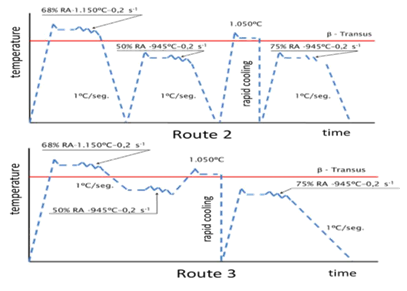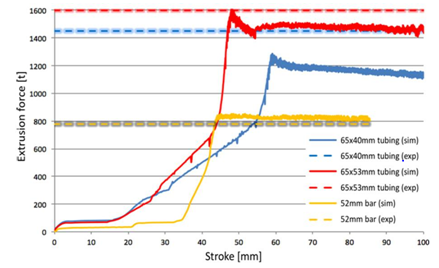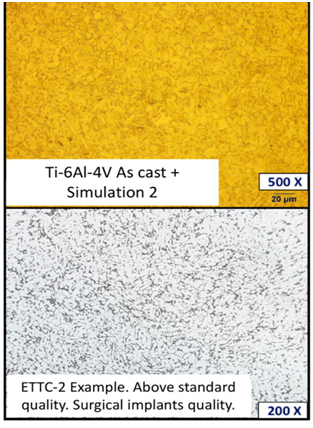eISSN: 2574-9927


Mini Review Volume 3 Issue 2
1 Universidad Tecnologica Nacional (UTN – FRBA), Argentina
2FAE S. A., Centro Atomico Ezeiza (CNEA), Argentina
3Instituto de Tecnologia Jorge Sabato, Centro Atomico Constituyentes (CNEA), Argentina
4Instituto Nacional de Tecnologia Industrial – Mecanica, Argentina
Correspondence: C Bunte, Universidad Tecnológica Nacional (UTN – FRBA), CABA, Argentina
Received: January 16, 2019 | Published: April 4, 2019
Citation: Bunte C, Deferrari N. Study of hot-workability of titanium alloys through hot-torsion testing and its application to the optimization of forging and extrusion processes. Material Sci & Eng. 2019;3(2):60-61. DOI: 10.15406/mseij.2019.03.00091
The hot-workability of aeronautical quality titanium alloys was studied through hot torsion testing. The results were used to define the material’s plastic behavior seeking to optimize forging and extrusion operating parameters. Additionally, different processing routes were simulated and the resulting microstructures were analyzed. The results of hot-workability testing and the information registered in full-scale extrusion tests were used to build a finite element (FE) model. Finally, the feasibility of extruding different sections was determined and the operating parameters were optimized to maintain the extrusion pressure within operative limits as well as to obtain the properties and microstructure required by current standards.
Keywords: thermo mechanical simulation, FEAPrimary processing is key to define the final properties of a metallic product, and more so when deformation from subsequent forming operations is not significant. With titanium alloys, primary reduction is done exclusively above β-transus (α/β phase-change temperature). Additional area reduction is mostly done below β-transus, where microstructure refinement and thus yield strength and ductility are directly linked to the amount of deformation in the α+β range.1 Hot-workability, which also improves with grain refinement, is limited to a narrow temperature gap in most titanium alloys. Grain growth and phase change to β limit the upper forming temperature, while crack formation limits the lower one. Hot-torsion testing was used due to its distinctive advantages. In particular, great strains at constant strain rate can be applied without severely changing the specimen’s geometry. Also, homogenous deformation is favored, since the absence of friction and necking, as in compression and tensile testing, reduces strain localization.
Cylindrical specimens (7mm in diameter with a 7mm calibrated length) were CNC machined from 1500t as-cast billets and 130mm diameter forged bars (68 % area reduction at 950°C) made in-house at FAE in a double VAR process. After testing, the specimens were cold-cut, sanded up to 1500 grit and polished with ammonium dichromate (ashes) in a 0.5 % HF solution. Finally, microstructures were revealed by 5s immersion in an 85% H2O + 10% HF + 5 % HNO3 solution. Table 1 summarizes the performed tests. For each temperature the specimens were tested at 3 different strain rates (0.1, 1 and 10s-1) until failure. Additional testing was performed to simulate processing routes. Route 1 is a typical sequence of β plus α+β forging (80% area reduction, 945°C, 0.2 s-1). Routes 2 and 3 are shown in Figure 1.

Figure 1 Simulated processing routes.2
Alloy |
Condition |
Forming T˚ in β [˚C] |
Forming T˚ in α + β + [˚C] |
||
Ti CP Gr 2 |
As cast |
960 |
840 |
760 |
700 |
Ti-6Al-4V |
As cast |
1150 |
950 |
|
|
Forged |
|
950 |
900 |
|
|
Table 1 Flow stress tests
Flow stress curves were obtained from the torque curves using Fields & Backofen’s method.2 Ti CP Gr 2 flow curves were used in the FE model, together with temperature measurements, ring tests, and experimental data obtained from full-scale extrusion tests in a 1600t horizontal press.3 A machine overload during those tests was reproduced. Figure 2 shows the good correlation between4 the FE model and the data acquired experimentally, especially with the geometry which caused the failure (65ext/53int mm diameter tubing). The microstructure obtained with the thermo mechanical simulations in Ti-6Al-4V was compared with the ETTC-25 and ISO 20160:20066 standards. All three simulations resulted in microstructures of above standard classification as shown in Figure 3. The effect of plastic deformation in the α+β range was also studied. Comparing Route 1 simulations with varying amounts of α+β deformation, it was concluded that a 50% reduction in the α+β range is needed to fully break the acicular structure obtained after cooling from above β-transus.

Figure 2 Experimental and FEA extrusion force.4

Figure 3 Results of thermo mechanical simulation (Route 2) after annealing compared with ETTC-2.2
Most of this work was done at laboratories at IAS (hot-torsion), CNEA (metallography) and INTI (FEA). Authors would like to thank such invaluable help.
Author declares that there is no conflicts of interest.

©2019 Bunte, et al. This is an open access article distributed under the terms of the, which permits unrestricted use, distribution, and build upon your work non-commercially.